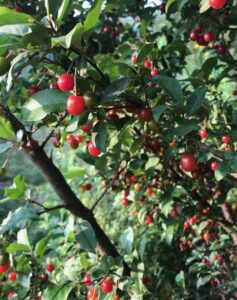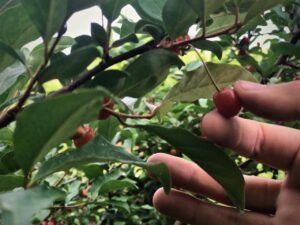Elaeagnus multiflora
Goumi berries (not gummy bears) are one of our favorite springtime treats. They’re beautifully bright red with silver speckles and are both antioxidant and anti-inflammatory. Plus, their seeds have significant amounts essential fatty acids. Not to mention, they’re ripe at the very beginning of fruit and berry season (May around here), and they’re easy to grow. The “goumi on top” is that their flowers smell divinely intoxicating, both to people and to pollinators and other beneficial insects.
Are goumi berries a native plant?
Goumi berries are not native to North America. In fact, this beautiful and productive perennial shrub hails from the Far East; its native range includes Eastern Russia, China, Korea, and Japan. There, the plants are fairly common and are considered to have both nutritional and medicinal value.
Here in Southern Appalachia, one of goumi berry’s Middle Eastern cousins has become naturalized: autumn olive (Elaeagnus umbellata). Unlike goumi, autumn olive is considered invasive and spreads easily and rather quickly. Additionally, autumn olives are ripe in the fall, around the same time as American persimmons. Goumi berries, on the other hand, don’t spread, so they’re not considered invasive. We still love autumn olives, though, even though they can be overly-enthusiastic. That’s because they also make tasty and nutritious berries and they’re super easy to cultivate. But goumi is a more well-behaved guest on this continent, to be sure.
How to grow your own goumi berries
You can grow goumi berries from seeds or from rooted cuttings. The most common cultivar is called “Sweet Scarlet.” This one was selected for large and sweet berries at the Kiev Botanical Gardens in Ukraine. If you grow goumis from seed, the fruit size and qualities will be variable. On the other hand, if you purchase this known variety, you’ll be sure to get big, sweet fruit.
Goumis are hardy in USDA zones 5-9. They can thrive in a wide range of soil types, partially because they fix their own nitrogen, like beans and peas. These sturdy, slightly thorny plants will grow to become fairly large (up to 8 feet). They bear fruit after the first 2 years or so. According to University of Wisconsin field trials, goumis have good potential for commercial production, including mechanical harvesting. In our trials, we’ve found that toddlers and young children also do a fabulous job at harvesting (into their own mouths).
Where to get goumi berries to plant
Several plant nurseries around the country sell both live plants (the well-known Sweet Scarlet cultivar), and some sell seeds. Additionally, if you know anyone who grows goumi berries, you can propagate more of them from seed (but remember, their fruit characteristics will be variable in this case). One source for goumi berry plants and seeds is Burnt Ridge Nursery in the Pacific Northwest. They’ll ship plants anywhere in the country. Another great source, including cultivars other than “sweet scarlet,” is One Green World Nursery.
If goumis get you going and you’re excited to learn more about unusual, useful plants, including how to add them to your landscape, join us! Each September we host a Permaculture Design Course, and we teach about lots of our favorite plants.





